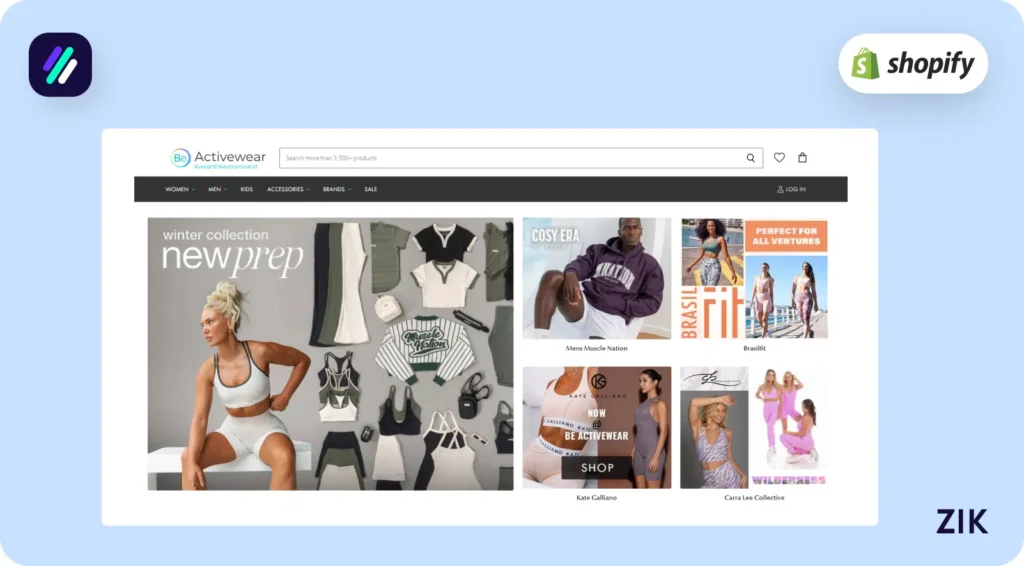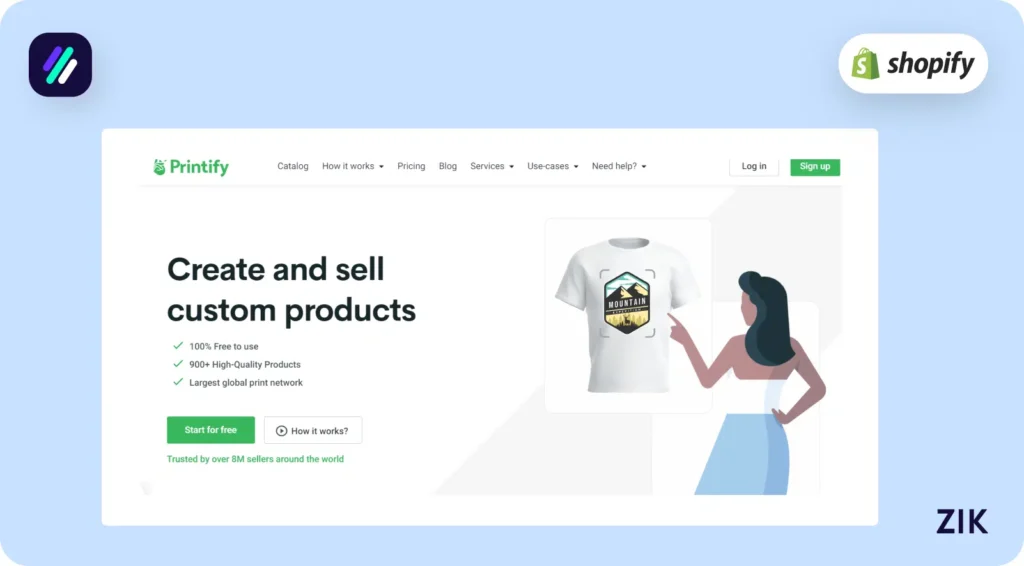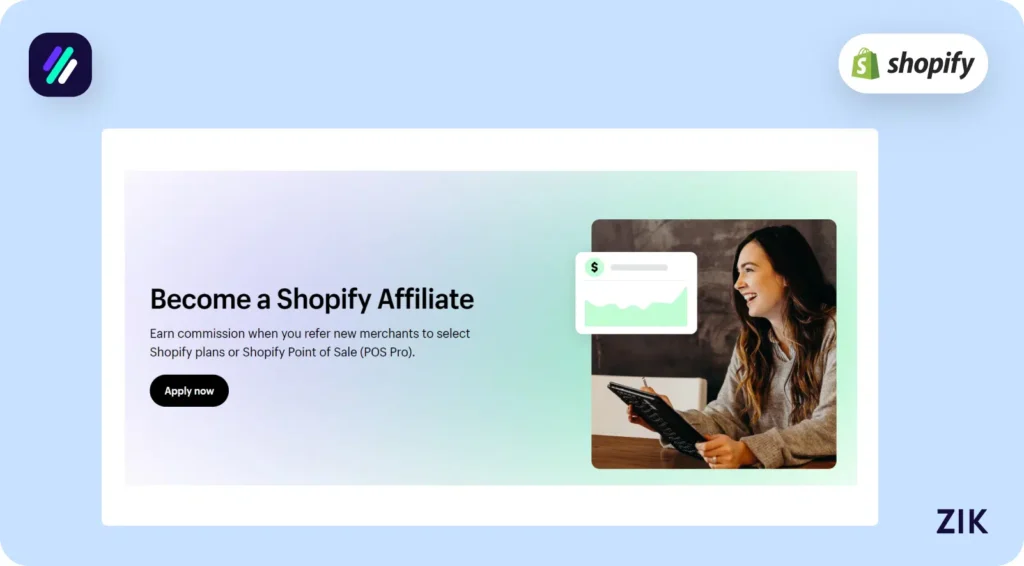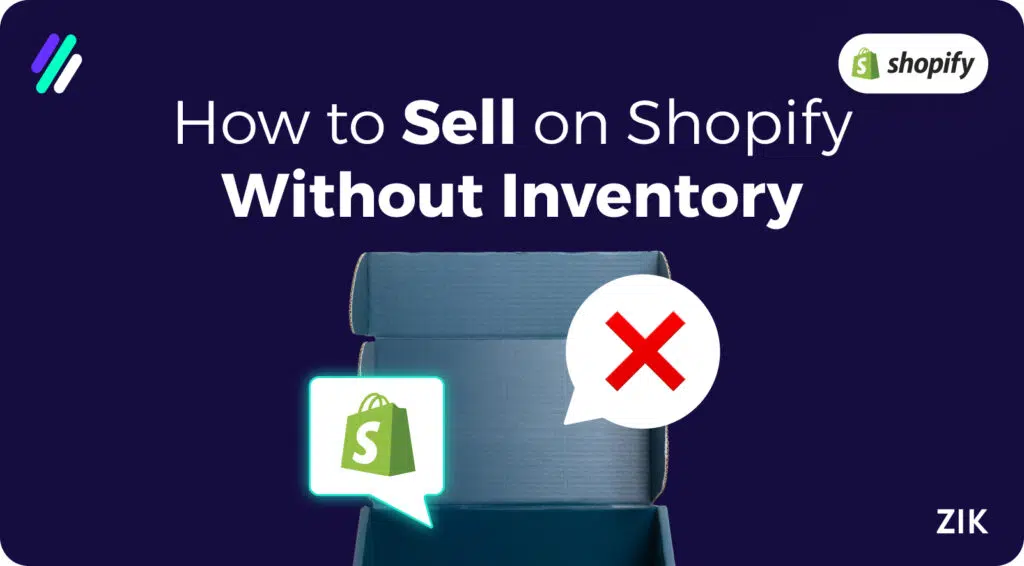You might believe you need to have an inventory of products to start an ecommerce business – you are wrong! A growing number of Shopify store owners don’t manage inventory.
Indeed, it’s possible to sell on Shopify without inventory management. If you’re wondering what business model to use to set up your Shopify store, you’ve come to the right place!
I’ve created multiple guides that help online business owners start an online store, and this one tackles starting a Shopify store without inventory.
You’d be surprised how many business models are available if you don’t want to manage a physical inventory.
The options are endless, from building a dropshipping business to a print-on-demand service. If you’re curious about what’s trending, tools like ZIK AdSpy let you peek at winning product ads so you can launch without holding stock yourself.
Keep reading to find out how to sell on Shopify without inventory!

Key Takeaways
- Four business models are available if you want to sell on Shopify without inventory or investing in products to sell.
- Dropshipping is the most popular option for selling without an inventory, but other options exist, such as print on demand, digital products, and affiliate selling.
- Discover the pros and cons of each business model to make money online without inventory.
Why Sell on Shopify Without Inventory?
Before the rise of ecommerce businesses, it was impossible to think about starting a business without any products. But that has changed since the advent of online business and ecommerce platforms!
In fact, there are many online store owners who make hundreds to thousands of dollars in profits without a physical inventory of products.
The main advantage of starting a Shopify store without managing inventory is the low startup costs.
Without keeping a physical inventory of products, you don’t have to pay upfront for the products that you need to sell. This makes it advantageous for low-budget online store owners.
Another benefit of knowing how to sell on Shopify without inventory is the lack of inventory management. From renting a storage space to keep your stocks to organizing your products, you could save time and costs in managing your inventory.
If you want more flexibility and the ability to scale your online business, choosing a business model without inventory is the best way.
You have more flexibility in adding products online since you are not limited by your storage space or startup costs.
It allows you to test out different niches and products online to determine what will be most profitable for your business.
In addition, it makes it easier to scale your online store, as you can grow your customer base when you add more products online.
How to Sell on Shopify Without Inventory
If you’re looking for a business model that allows you to sell on Shopify without a physical inventory, these four business models are available.
1. Dropshipping Business

Dropshipping is a popular business model among Shopify store owners who want to start an online business without managing inventory. You might have heard about dropshipping if you’ve been looking for Shopify store business ideas.
The dropshipping business model involves selling products online directly from a dropshipping supplier. The model works by adding products to your online store.
You will only be responsible for setting up your ecommerce website and adding products to your store. When a customer purchases, you must forward the customer order information to the dropshipping supplier.
The supplier is responsible for fulfilling and shipping the orders to your customer. Most dropshipping businesses tell the customer that they don’t hold inventory in-house and that the supplier will be responsible for fulfilling orders and shipments.
Dropshipping is the most popular selling model without holding an inventory.
When you dropship products, your success lies in finding a reliable dropshipping supplier. Finding reliable suppliers can make or break your business since they are responsible for fulfilling, packing, and shipping customer orders.
Aside from choosing suppliers, you can dropship products to your Shopify business through retail services, such as Aliexpress. It is an easy business idea since you don’t necessarily have to offer a unique product idea to start selling on your Shopify store.
In addition to finding reliable suppliers, it is crucial to monitor the shipping costs charged by each supplier. This will help you maintain profitability for your online business.
Pros of Dropshipping
- Low barrier to entry—You don’t need a large investment, and you will only allocate money for products that customers order from your store. It is a low-cost startup idea.
- Risk-free—You can choose different niches or products for your store to test their profitability for your business.
- Flexibility – It is easy to scale and maximize the product offerings to match your business needs.
Cons of Dropshipping
- Low-profit margin—Since you can get the products at a lower price, the profit margin is also low. The competitive nature of the dropshipping industry requires you to keep your products affordable to maintain profits.
- Lack of supply chain control – Choosing dropshipping suppliers is the most important aspect of your business. You must find reliable partners because you won’t be able to inspect your products for quality.
- Lack of branding – Since you are sourcing products from dropshipping suppliers, it is difficult to establish a brand and stand out from the competition.
2. Print on Demand

The print-on-demand service is another option that would be a great idea for starting Shopify stores without inventory. For this business model, you must choose a print-on-demand service provider to partner with for your business.
You will sell customized and design-focused products online. You must upload the product designs to your online stores, such as t-shirts, mugs, bags, phone cases, and more.
When a customer places an order, you will send the order details to the print-on-demand company, which will be responsible for printing the custom products.
After they have created the custom designs, they will take care of the shipping process to your customers.
You can find print on demand apps on the Shopify App Store, such as Printify and Printful.
Choosing third-party apps from the Shopify App Store allows seamless integration with your online businesses, so you can generate revenue from potential customers without your own warehouse or acquiring printing equipment, just like traditional retail models.
Pros of Print on Demand
- Lucrative business idea – The print on demand market has an estimated value of 67.5 billion by 2032, according to Precedence Research. It has an annual growth rate of 26.71% from 2024 to 2026.
- Creative Freedom—The print on demand business model is an excellent business idea if you are passionate about creating and designing products. It is a good way to showcase your creativity through the products you sell online.
- Create Unique Products—The endless personalization options and design ideas can make it easy to sell online. This also adds to the appeal of products, as potential customers can select their own designs.
- Online Branding – You can use print on demand service to establish your unique brand identity. It becomes easier to sell products using your logo or patented designs. This design approach adds to your differentiation from other online businesses.
Cons of Print on Demand
- Low profit margin—Although you can sell on Shopify without inventory with print-on-demand services, it entails higher per-unit costs, so the profit margin potential is lower. This business idea has limited pricing power due to the high competition.
- Longer products—Customized products take longer to fulfill since you can run out of supplier problems, such as supplies, which can lower customer satisfaction rates. Unfortunately, you have no control over this process because that is how this business model works.
- Lack of Customer Insights—Limited access to customer data and feedback makes it difficult to revamp your business and optimize your marketing strategies.
3. Digital Products
You can sell digital products online if you want to know how to sell on Shopify without inventory.
Selling digital products is a good model for an ecommerce business without the hassle of managing inventory. In addition, selling digital products requires almost no overhead costs, making it a low-risk business idea.
You can sell various digital products online, such as software, online courses, e-Books, and digital art.
You won’t have to think about storage space or the shipping process because when you sell digital products, you can provide instant download or digital delivery options.

If you have a Shopify store, the good news is that it allows the sale of digital products. There is also a built-in feature that allows you to sell digital products that require an easy setup.
The advantage of digital products is that you can access a worldwide customer base.
Since you won’t have to worry about the shipping process of physical products, you can sell products online to anyone in any part of the world. Your customers can download or access the digital products online.
In addition, the number of stocks you can keep is unlimited, which is the challenge of managing physical products for your Shopify store. With digital products, you can offer unlimited downloads to your customers.
And lastly, there are no fulfilment costs involved. Any savings you can get can translate into a higher profit margin.
With digital products, you won’t have to pay extra for order fulfilment or inventory management, so you can get more profit margins and higher profits for higher demand.
However, this selling model is not without some challenges. The marketplace for digital products is saturated because of the low-risk and easy startup.
Also, you must compete with other online store owners offering free products to attract more customers.
Once you have decided to sell digital products online, you must research and consider what products to offer.
The first thing to consider is your skills and experience. If you want to sell more digital products, you must be able to offer something of value to your customers.
Your expertise and skills can directly impact customers’ buying decisions because they can affect the perceived value of your digital products.
Another factor is your interest. If you are enthusiastic about photography, you can offer digital products or courses on editing or selling photos online.
Or, if you are into music, you can create online tutorials on how to play a guitar or other musical instruments.
Here are ideas on digital products to sell:
- Stock photography
- Online courses
- Digital art and graphic design
- Webinars
- Consulting sessions
- Games
- Software
- Downloadable prints
- Templates
Pros of Selling Digital Products
- Huge demand
- No hassle with shipping and logistics
- Diverse product options
- No limit to products
Cons of Selling Digital Products
- Risk of piracy
- Competitive market
4. Selling Affiliate Products

Selling affiliate products is another way to sell on Shopify without inventory. It effectively involves finding an affiliate partners who will supply the products or services to your potential customers.
When you sell affiliate products, you will earn a commission fee for each sale you generate from your website.
If you want to sell affiliate products, you should find a reputable affiliate partner. It will help align your marketing strategies to increase revenue and brand growth.
To start selling affiliate products, you must choose a product or niche. The affiliate products must align with your target market and their interests. The next step is to select an affiliate partner or program for which you must sign up.
Once you are an affiliate, you will be designated a unique affiliate code.
Once you set up your Shopify store and start listing affiliate products, write compelling product descriptions and use other marketing strategies to attract more customers to your shop.
You will earn a commission on your store for each successful sale. The more products you sell, the higher your commission.
Pros of Selling Affiliate Products
- Minimal investment
- Easy startup
- Flexible
- Extensive product options
Cons of Selling Affiliate Products
- Affiliate partner controls the rules
- No guarantee of revenue
- Sell more to make more money
Conclusion: How to Sell on Shopify Without Inventory
No matter your business model, it is easy to make money on Shopify without an inventory. Choosing a trusted and reliable partner for your ecommerce store is the secret to success in this business model.
Whether you’re selling clothes or digital products, knowing how to promote your store effectively is the way to ensure success! You can employ social media marketing and other digital marketing techniques to get your products out there.
Launch Smarter with Shopify Sales Tracker
Want to succeed without holding inventory? Use ZIK’s Shopify sales tracker to uncover real sales data from top-performing stores using dropshipping, POD, or affiliate models. Track what’s working, analyze profitable niches, and find winning products—without ever touching stock. It’s the easiest way to launch a data-backed Shopify store without inventory.
Frequently Asked Questions on How to Sell on Shopify Without Inventory
Here are some frequently asked questions on how to sell on Shopify without inventory:
Can you sell on Shopify without inventory?
Yes, you can sell on Shopify without holding inventory by using dropshipping, print-on-demand, or digital products. These models let suppliers handle production and shipping, while you focus on marketing and customer service. It reduces upfront costs but requires strong supplier partnerships and branding.
How to sell merchandise without inventory?
You can sell merchandise without inventory through dropshipping or print-on-demand, where suppliers handle production and shipping once customers order. Digital products are another option with no stock required. This model reduces risk and costs, letting you focus on marketing, branding, and customer acquisition instead.
Can I sell on Shopify as an individual?
Yes, you can sell on Shopify as an individual without registering a formal company. Many sellers start as sole proprietors using personal details for payouts. However, depending on local tax laws, you may later need a business license or registration for compliance.
Can I sell directly on Shopify?
Yes, you can sell directly on Shopify by setting up an online store, adding products, and enabling payment gateways like Shopify Payments or PayPal. Customers purchase straight from your site, and you manage orders, shipping, or digital delivery without relying on third-party marketplaces.
How do I not show inventory on Shopify?
To hide inventory, go to your Shopify admin, open the product settings, and uncheck “Track quantity.” This prevents stock numbers from displaying to customers while still allowing purchases. It’s useful for made-to-order items, digital products, or when you prefer not to show stock levels.
How to set up a Shopify collective?
To set up Shopify Collective, log in to your Shopify admin and install the Collective app. Connect with approved US-based brands, then import their products into your store. You earn commissions when sales occur, while suppliers handle fulfillment. Approval and eligibility may vary by region.
Does Shopify track your inventory?
Yes, Shopify tracks your inventory if you enable the “Track quantity” option in product settings. It automatically adjusts stock levels as sales occur and alerts you when items run low or sell out. This helps manage orders, prevent overselling, and streamline restocking.
How to hide a Shopify product?
To hide a product, go to your Shopify admin, open the product page, and under Sales Channels, deselect Online Store or any active channel. Saving these changes removes it from visibility without deleting. You can also set availability dates to control when it appears.
What is a smart collection in Shopify?
A smart collection in Shopify is an automated product group created using set conditions like tags, price, or vendor. Products that meet those rules are automatically added, saving time on manual updates. This feature helps organize stores and improves product discovery for customers.













